Uncategorized
Photos // Autumn on colour 120mm film
Photos // Black and white 120mm film
Review // The Next Step in the Dance
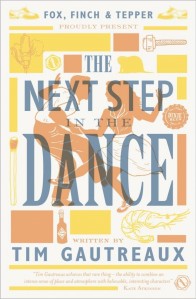 The Next Step in the Dance
The Next Step in the Dance
by Tim Gautreaux
4/5
This emotional, slow-burner of a novel was amongst the pile recommended to me at my recent Book Spa at Mr B’s Emporium in Bath. The store runs its very own publishing company, Fox, Finch & Tepper – aptly named after some of the most iconic literary characters. FF&T books are under-appreciated and crying out for some attention. Tim Gautreaux’s The Next Step in the Dance was actually published back in 1998 before falling out of circulation, and was picked up by the FF&T team back in 2014. Focusing on books with a strong sense of place with brave, confident characters, FF&T have succeeded in reviving a beautiful book with a heart as big as Louisiana itself.
Paul and Colette Thibodeaux are husband and wife at the very start of their marriage. Born and still living in the Deep South along the bayou, neither of them have ventured further than their little town of Tiger Island. The community is inward looking, small and timeless, and Colette is bored. She wants adventure and new things, and so sets out to California to discover something different. Paul eventually follows, and the narrative becomes a touching portrayal of two individuals trying to make sense of big city life.
Without giving too much away, this story has extremely emotional ups and downs, with a tense, testing build up to its happy, homely ending. FF&T weren’t wrong in choosing to publish this book for it’s sense of place. Gautreaux talks constantly and nostalgically about Cajun food, smells, sights and nights in bars. The bayou landscape is unique and all-encompassing, almost as hard to live in as the Thibodeauxs’ tenacious relationship. Thoroughly recommended.
Living with Books
When my partner and I moved in together we knew we had to look for a two bedroom place. Not because we were planning a brood of babies anytime soon, but because the amount of books at our respective mothers’ houses was too overwhelming to sleep in the same room as… He studies philosophy, and as such has a huge back catalogue of classic texts, chunky textbooks and piles of papers and journals. Along with the sizeable coffee table books I accumulated at art school and the sheer amount I fiction I get through on a monthly basis, we had a terrifying amount of books. And neither of us were willing to part with any of our titles…
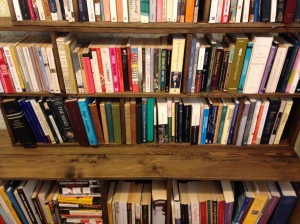
In our rented two bedroom flat, we don’t have the ability to build our own library. As much as we’d love to line our rooms with bespoke shelving, we’re barely allowed to put a nail in our walls. So what do you do with limited space, tonnes of books and a Pinterest board full of ideas?
First off, I picked our favourite covers and separated them from the ones I knew we’d only put on shelves. In a rented flat I think it’s important to inject as much personality as possible into your space, and doing it with books is a great way to do it. I filled alcoves with curated piles of paperbacks, placed them on shelves like prints, and put my ‘currently reading’ pile strategically on the coffee table.
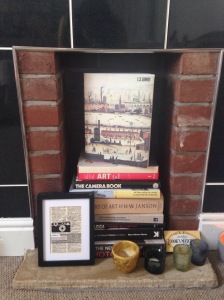 For those books that we didn’t necessarily want on show, we invested in a few vintage trunks. Perfect for unsightly piles of books that need to go somewhere, and even better for DVDs which I can’t stand having stacked up gathering dust near our TV. My partner has a dedicated trunk for books that he’s currently using for his studies, that way he knows exactly where he can find them when he needs them.
For those books that we didn’t necessarily want on show, we invested in a few vintage trunks. Perfect for unsightly piles of books that need to go somewhere, and even better for DVDs which I can’t stand having stacked up gathering dust near our TV. My partner has a dedicated trunk for books that he’s currently using for his studies, that way he knows exactly where he can find them when he needs them.
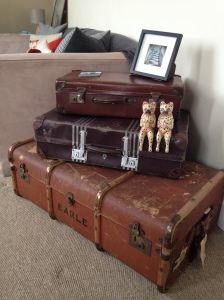
Finally, we enlisted the help of my very talented father to build us some bespoke stand alone bookshelves. He used recycled wood to build us some beautiful shelves with compartments of different shapes and sizes. He made three sets of shelves separately, and then screwed them together the way we wanted them. That way we can take them apart and shuffle them around when we want to. I think you’ll agree they’re pretty stunning!
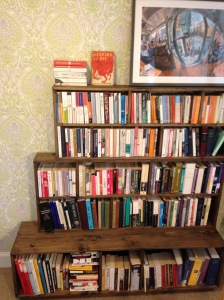
For all those titles that didn’t quite make it onto a shelf, we bought a cheap set of IKEA stand alone shelves and popped them in the spare room… But I’m not going to take a photograph of that, as they are starting to over-spill into piles along the walls and windowsills… It’s very much a work in progress, but it’s great knowing I can shut the door on the spare room and not have to worry about piles of books towering over me when trying to sleep! One day, when we have our own place, I’ll build myself that reading nook I’ve always wanted… Until then, I’ll carry on getting creative with my book storage 🙂
Discovering Copenhagen on a Budget
Last week we packed up some reading materials and headed to the Danish capital of Copenhagen for some real R&R. Armed with just a few thousand Krone, we wanted to make sure that we saw as much of the city as possible for as little as we could.
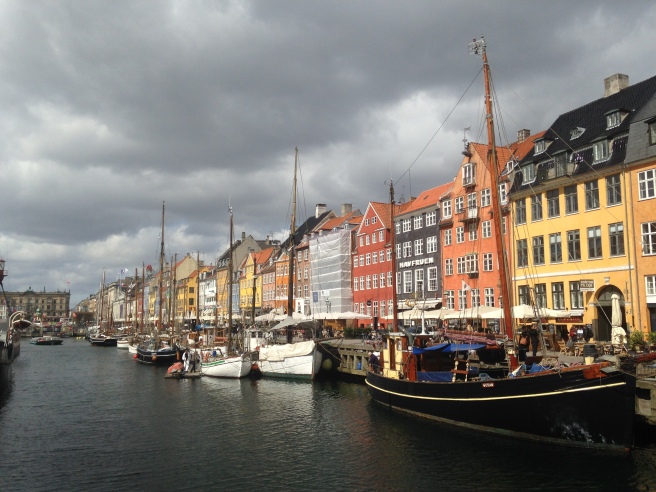
Before heading to the city, we were warned it would be an expensive trip. But upon arriving, that idea didn’t seem to add up to our overall first impression. Jumping off the metro at Nørreport into the heart of the city, it’s plain to see that the place isn’t flashy, and it seems that throwaway culture doesn’t really exist here. The bikes that swarm the cycle lanes across Copenhagen are all well-worn, and the hordes of bike repair shops have a steady stream of customers fixing punctures or getting a spruce-up. Copenhagen city kids are content to be outdoors, climbing the frames in the many family-friendly parks. Coffee shops and restaurants are filled with genuine vintage decor. Rustic wooden crates and well-worn furniture rival that of the ‘vintage inspired’ decor that comes with a hefty price tag at home. As our flights from Manchester came in at under £100, and we bagged three nights in a hygge apartment in the heart of Nørrebro for less than £150; we were surprised to learn that Copenhagen has a reputation for being one of the most expensive cities in Europe.
We discovered that when the weather’s good, there’s so much to see and do in the fresh air. The myriad parks and gardens are perfect for strolling with a takeaway Kaffe and a fresh Danish pastry. Street food vendors selling hot dogs, falafel and sandwiches are rife, and are perfect for lunch in the open air. A wander around Freetown Christiania is ideal for intrepid explorers looking for something off the beaten track, and there are plenty of stalls selling deliciously cheap food and drink. For something a little grander, taking in the palace of Slotsholm and its peaceful gardens is a must.

When the weather’s not so great, heading indoors to one of Copenhangen’s many free galleries or museums is a great way to while away a bitingly chilly Danish afternoon. We discovered the National Museet, which has a great exhibition of Viking and Renaissance objects; and the city’s Kunsthalle offers a great introduction to Danish art history.
Getting about cheaply in Copenhagen is a doddle. Avoid the taxis, which are painfully expensive, and take to the cycle lanes instead. Apartments and hotels often come with bikes included, but you should be prepared to take in a lot of the city on foot – by far the best way to make the most of the Old Town’s narrow cobbled streets, winding canals and expansive lakes.
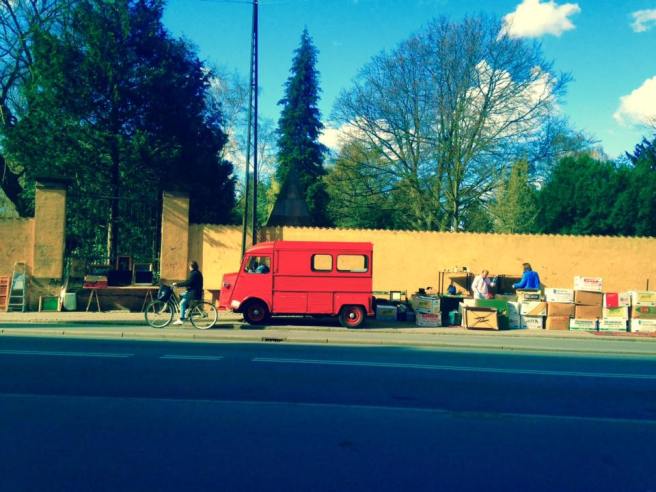
Those looking to take home a souvenir without breaking the purse strings must wander the city’s plenteous flea markets. From bits of vintage kitchenware to jewellery and old photographs, haggling for a bargain on the market is the ideal way to pick up something to remember Copenhagen by.
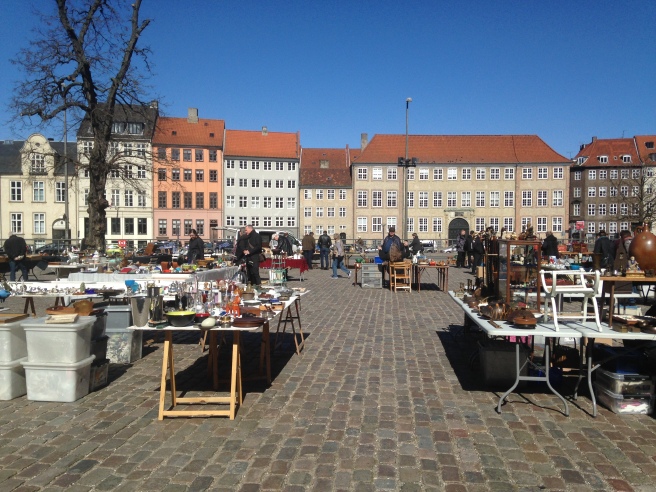
We saved our last few Krone for a trip to Tivoli, which didn’t exactly come under budget entertainment, but was the perfect showstopper for our final evening. Visit on a Friday night, when it’s a flat rate to get in and guests are rewarded with a spectacular music show featuring some of Denmark’s best bands. Once in, the rides are a little extra, but riding one of the world’s oldest wooden roller coaster is certainly worth the 100kr (about £10) we paid.

In terms of bookshops, we had a little rest from book hunting whilst we were off. This ended up as more of a writing trip than a reading trip, and it was great to flex our thinking muscles and get down some ideas for stories and bits of writing. With it’s super-relaxed atmosphere and plenteous places to sit and watch the world go by, we discovered that Copenhagen is a real paradise for thinking and writing.
Review // All the Light We Cannot See
4/5

Having met a little controversy with his ‘overly sentimental’ portrayal of World War II, I have to say that I don’t really mind too much about what some of the critics have said about All the Light We Cannot See. Some have fact-checked Doerr’s writing and found a few geographical inaccuracies. Others have accused him of not picking a side when it comes to the War itself. If I wanted a book that did all of the above to a tee, I would be reading non-fiction. Or my school textbook. When I pick up a book – and in particular a Pulitzer Prize winning book – all I’m looking for is a great story, challenging writing, and perhaps a new perspective. As All the Light We Cannot See ticked most of these boxes, there isn’t really much for me to complain about. Except that after hitting over 300 pages and discovering there was over 200 more to go, I do wish it would have been a little shorter.
All the Light begins in Paris, where we meet Marie-Laure, a terrified six year old who has recently lost her sight. With the help of her loving father, she is given an injection of confidence, and soon finds herself walking the paths of the Jardin des Plantes to the museum where her father works. Having spent a lot of time in Paris, I loved being taken through the streets with the help of Marie Laure’s cane. I could imagine the smells, the sounds and the bustle of energy that she would have felt. Fast forward a few years, and WWII has reached the city, and Marie-Laure and her father flee, having been entrusted with a priceless precious stone from the museum. The pair find themselves taking refuge in St Malo, a seaside town in France, where they stay with Marie-Laure’s Great Uncle.
In parallel to Marie-Laure’s story is that of Werner, a young and ‘feathery’ German boy who is groomed by the Nazi party thanks to his talent for fixing transmitter radios. He is sent away from his sister and the oprhanage where he grew up, and endures the gruelling regime of Hitler’s Youth Camp. He then joins the army on the front line in France, tasked with tracking the transmissions of the French Resistance.
Without giving too much away, it becomes a matter of time before Marie-Laure and Werner come across each other, and there’s a fantastic, pensive build-up until they do. This is short-lived, however, for when they do meet it’s a little anti-climactic, and I was already getting a little restless. This is redeemed slightly by the flip forward to the 1970s, and then to 2014, where we reconvene with some characters, and more loose ends are tied up.
All in all, the detail in All the Light We Cannot See is second to none. Not having an advanced history degree, I didn’t notice any of the mistakes that other reviewers have pointed out, but I also did have enough knowledge of WWII to appreciate the characters and their development. For me, the ending could have come a little sooner. But overall, All the Light was a thoughtful page-turner with those fantastically short chapters that you just can’t stop reading – and a clever little nod to the parallels in life that tend to go unnoticed.
Abandoning books
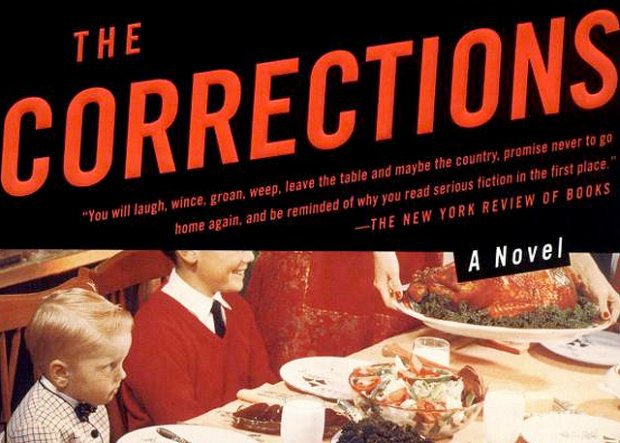
I can’t put my finger on why it makes me feel so bad to abandon a book. When I think back over the hundreds of books I’ve read, there have only been a handful that I’ve decided to put down for good. First there’s the wrestle with the decision to close the book for good. Then there’s taking your bookmark out knowing that this is final – there are no intentions of returning to it at a later date.
Lately I’ve abandoned Johnathon Franzen’s ‘critically acclaimed’ The Corrections. Franzen joins my growing pile of abandons alongside The God of Small Things, The Brief Wonderous Life of Oscar Wao and, controversially, Moby Dick. In abandoning these titles, I’ve realised that there are two types of abandonment guilt. The first one comes because somebody has recommended a book that you really don’t get on with – because you then have to deflate their enthusiasm with a declaration of ‘I didn’t finish it…’. The second type of guilt comes from the fear of missing out. Moby Dick, for example. A classic. Referenced so much in popular culture that I already felt like I’d been introduced to the characters before I even read it. Once I put my copy down after the third chapter, I knew that was it. I’ll probably never pick it up again, and I’ll probably die having never read Moby Dick. I’ve missed out.
The one thing that makes me feel little better about book abandonment is the list of books that I probably should have abandoned, but didn’t. I struggled through Proust’s Swann’s Way for about three months, at times simply glancing over words without registering them in my mind. I remember nothing about Swann, or his way. But I remember everything about the Richard Yates novel that I read prior to Proust – and The Easter Parade remains a firm favourite, going on to influence my reading list ever since.
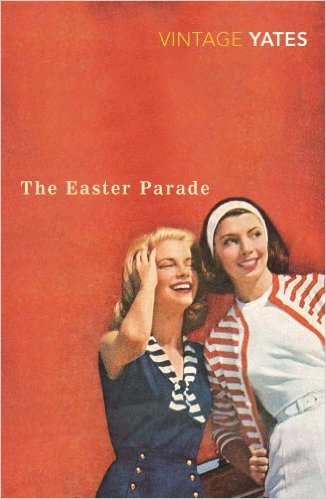
Reading isn’t something that you should get something out of, all the time. But it’s also not something that you should get absolutely nothing out of. So last week when I felt a twinge of abandonment guilt as I unfurled the dog ear marking my place in The Corrections, I thought of Proust. Or rather, I remembered that I remembered nothing. How ironic, for a book about the search for lost time.














